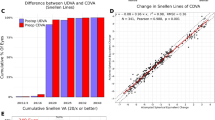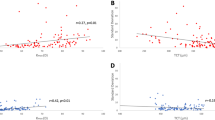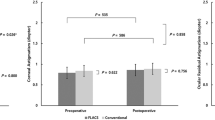Abstract
Aims
To investigate the accuracy of corneal flap thickness (FT) using two different age MK-2000 microkeratomes.
Methods
The prospective cohort study enroled 260 patients with refractive error. Flaps were created using two microkeratomes A and B (new and aged, respectively) with 130-μm heads in two patient groups and two times the same blade in both treated eyes of each patient. The variations in FTs were compared between two groups and between both operated eyes of each patient. The correlations were analysed between FT and CCT or keratometric power.
Results
In the A and B groups, the average FTs were 123.3±18.7 and 147.5±19.1 μm respectively. Difference in measurements between the actual FTs of first eye operations in the A group and intended 130 μm of FTs was not significant (P=0.462), but those of second operated eyes in the A group and both treated eyes in the B group were significant (P<0.001). Second cut achieved a thinner flap and increased the variability in FT, and an aged microkeratome achieved a thicker flap than a new microkeratome and than that claimed by the manufacturer. Positive correlations were observed between preoperative CCT and FT (P<0.05).
Conclusions
The first eye operation by a new MK-2000 microkeratome achieves the accuracy of the intended FT. FTs varied between first and second cuts of each patient and between two different age MK-2000 microkeratomes. LASIK surgeons should compare FT when using an aged MK-2000 microkeratome, and frequent and periodic comparison of FT achieved by all microkeratomes may be also recommended.
Similar content being viewed by others
Log in or create a free account to read this content
Gain free access to this article, as well as selected content from this journal and more on nature.com
or
References
Genth U, Mrochen M, Walti R, Salaheldine MM, Seiler T . Optical low coherence reflectometry for noncontact measurements of flap thickness during laser in situ keratomileusis. Ophthalmology 2002; 109: 973–978.
Binder PS . One thousand consecutive intralase laser in situ keratomileusis flap. J Cataract Refract Surg 2006; 32: 962–969.
Reinstein DZ, Srivannaboon S, Archer TJ, Silverman RH, Sutton H, Coleman DJ . Probability model of the inaccuracy of residual stromal thickness prediction to reduce the risk of ectasia after LASIK part I: quantifying individual risk. J Refract Surg 2006; 22: 851–860.
Reinstein DZ, Srivannaboon S, Archer TJ, Silverman RH, Sutton H, Coleman DJ . Probability model of the inaccuracy of residual stromal thickness prediction to reduce the risk of ectasia after LASIK part II: quantifying population risk. J Refract Surg 2006; 22: 861–870.
Schultze RL . Microkeratome update. Int Ophthalmol Clin 2002; 42: 55–65.
Lin RT, Lu S, Wang LL, Kim ES, Bradley J . Safety of laser in situ keratomileusis performed under ultra-thin corneal flaps. J Refract Surg 2003; 19: S231–S236.
Flanagan GW, Binder PS . Role of flap thickness in laser in situ keratomileusis enhancement for refractive undercorrection. J Cataract Refract Surg 2006; 32: 1129–1141.
Arbelaez MC . Nidek MK 2000 microkeratome clinical evalution. J Refract Surg 2002; 18: S357–S360.
Munoz G, Albarran-Diego C, Sakla HE, Perez-santonja JJ, Alio JL . Femtosecond laser in situ keratomileusis after radial keratomy. J Cataract Refract Surg 2006; 32: 1270–1275.
Seiler T, Koufala K, Richter G . Iatrogenic keratoectasia after laser in situ keratomileusis. J Refract Surg 1998; 14: 312–317.
Seo KY, Wan XH, Jang JW, Lee JB, Kim MJ, Kim EK . Effect of microkeratome suction duration on corneal flap thickness and incision angle. J Refract Surg 2002; 18: 715–719.
Jackson DW, Wang L, Koch DD . Accuracy and precision of the Amadeus microkeratome in producing LASIK flaps. Cornea 2003; 22: 504–507.
Gailitis RP, Lagzdins M . Factors that affect corneal flap thickness with the Hansatome microkeratome. J Refract Surg 2002; 18: 439–443.
Giledi O, Mulhern MG, Espinosa M, Kerr A, Daya MS . Reproducibility of LASIK flap thickness using the Hanastome microkeratome. J Cataract Refract Surg 2004; 30: 1031–1037.
Shemesh G, Dotan G, Lipshitz I . Predictability of corneal flap thickness in laser in situ keratomileusis using three different microkeratomes. J Refract Surg 2002; 18: S347–S351.
Sarkisian KA, Petrov AA . Experience with the Nidek MK-2000 Microkeratome in 1220 Cases. J Refract Surg 2001; 17: 252–254.
Soloman KD, Donnenfeld E, Sandoval PH, Sarraf OA, Kasper TJ, Holzer MP et al. Flap thickness accuracy: comparison of 6 microkeratome models. J Cataract Refract Surg 2004; 30: 946–977.
Naripthaphan P, Vongthongsri A . Evaluation of the reliability of the Nidek MK-2000 microkeratome for laser in situ keratomileusis. J Refract Surg 2001; 17: S255–S258.
Schumer DJ, Bains HS . The Nidek MK-2000 microkeratome system. J Refract Surg 2001; 17 (2 suppl): S250–S251.
Flanagan GW, Binder PS . Precision of flap measurements for laser in situ keratomileusis in 4428 Eyes. J Refract Surg 2003; 19: 113–123.
Choi YI, Park SJ, Song BJ . Corneal flap dimensions in laser in situ keratomileusis using the Innovatome automatic microkeratome. Korean J Ophthalmol 2000; 14: 7–11.
Thompson RW, Choi DM, Price MO, Potrezbowski L, Price Jr FW . Noncontact optical coherence tomography for measurement of corneal flap and residual stromal bed thickness after laser in situ keratomileusis. J Refract Surg 2003; 19: 507–515.
Jacobs BJ, Deutsch TA, Rubenstein JB . Reproducibility of corneal flap thickness in LASIK. Ophthalmic Surg Laser 1999; 30: 350–353.
Kim JH, Lee D, Rhee KI . Flap thickness reproducibility in laser in situ keratomileusis with a femtosecond laser: optical coherence tomography measurement. J Cataract Refract Surg 2008; 34 (1): 132–136.
Li Y, Netto MV, Shekhar R, Krueger RR, Huang D . A longitudinal study of LASIK flap and stromal thickness with high-speed optical coherence tomography. Ophthalmology 2007; 114 (6): 1124–1132.
Avila M, Li Y, Song JC, Huang D . High-speed optical coherence tomography for management after laser in situ keratomileusis. J Cataract Refract Surg 2006; 32 (11): 1836–1842.
Gokmen F, Jester JV, Petroll WM, McCulley JP, Cavanagh HD . In vivo confocal microscopy through-focusing to measure corneal flap thickness after laser in situ keratomileusis. J Cataract Refract Surg 2002; 28 (6): 962–970.
Wang J, Thomas J, Cox I, Rollins A . Noncontact measurements of central corneal epithelial and flap thickness after laser in situ keratomileusis. Invest Ophthalmol Vis Sci 2004; 45 (6): 1812–1816.
Randleman JB, Hewitt SM, Lynn MJ, Stulting RD . A comparison of 2 methods for estimating residual stromal bed thickness before repeat LASIK. Ophthalmology 2005; 112 (1): 98–103.
Author information
Authors and Affiliations
Corresponding author
Additional information
Conflict of interest: The authors declare no conflict of interest.
Financial interest: None
Rights and permissions
About this article
Cite this article
Hsu, SY., Liu, YL., Chang, MS. et al. Accuracy of corneal flap thickness achieved by two different age MK-2000 microkeratomes. Eye 23, 2200–2205 (2009). https://doi.org/10.1038/eye.2008.435
Received:
Accepted:
Published:
Issue date:
DOI: https://doi.org/10.1038/eye.2008.435



